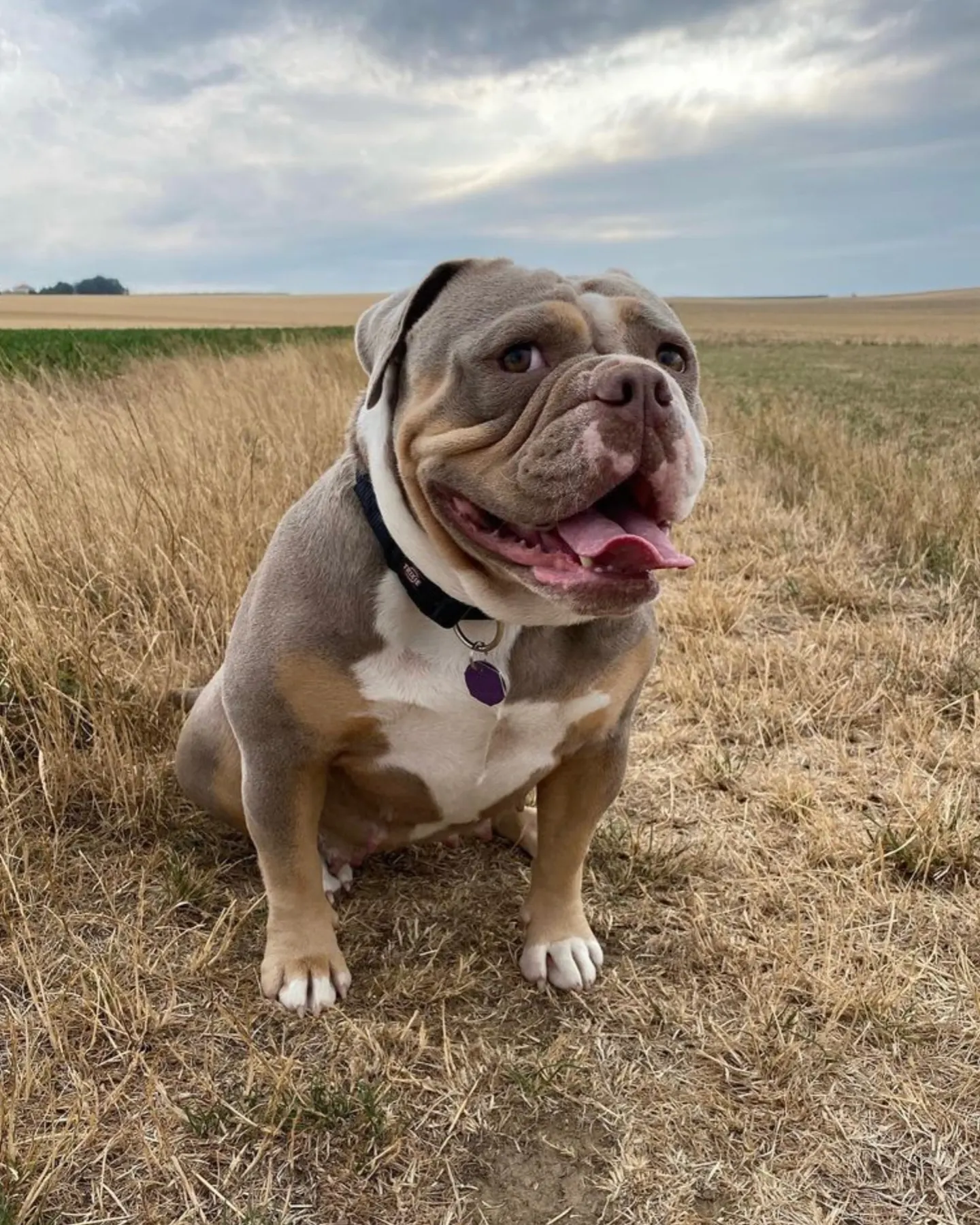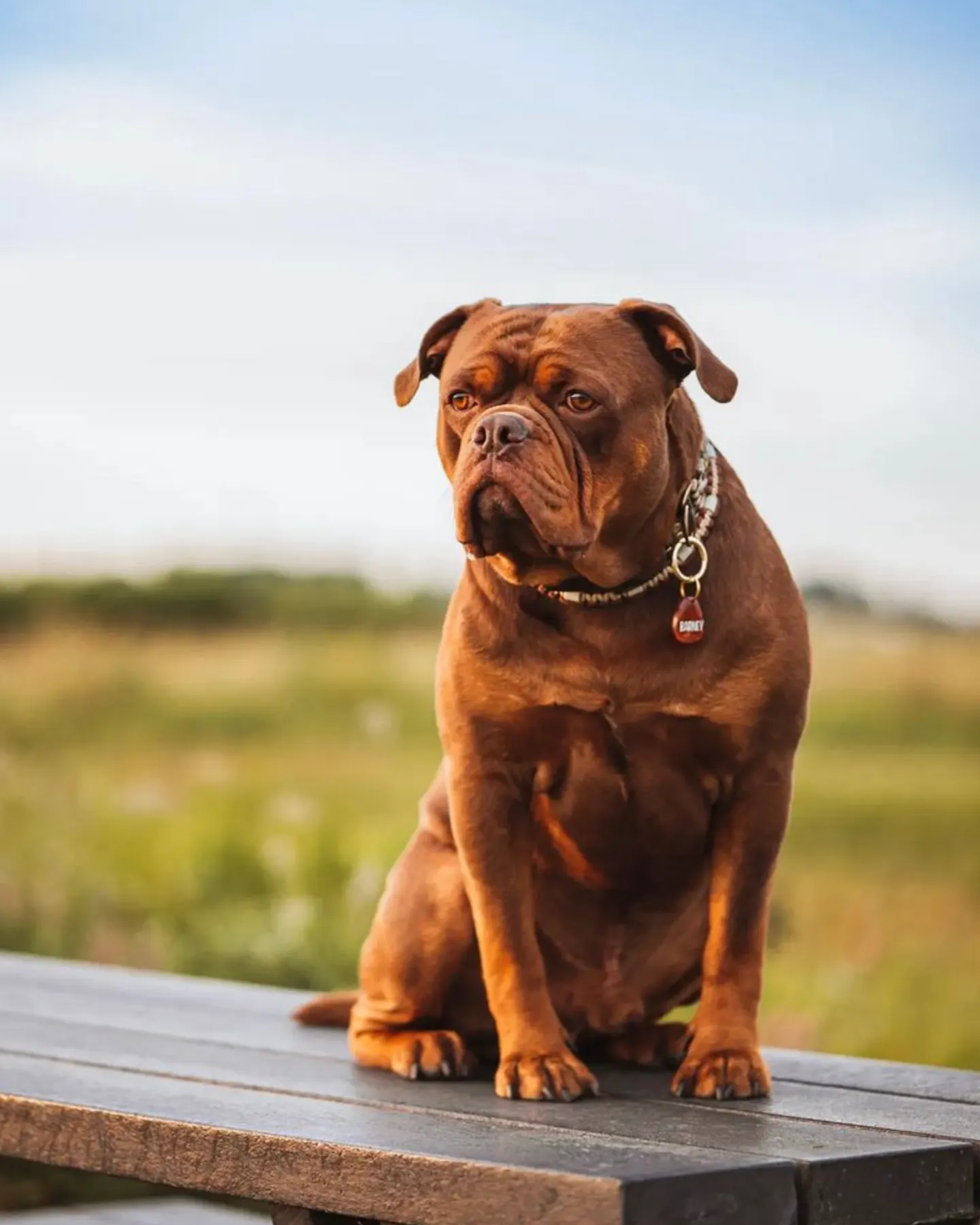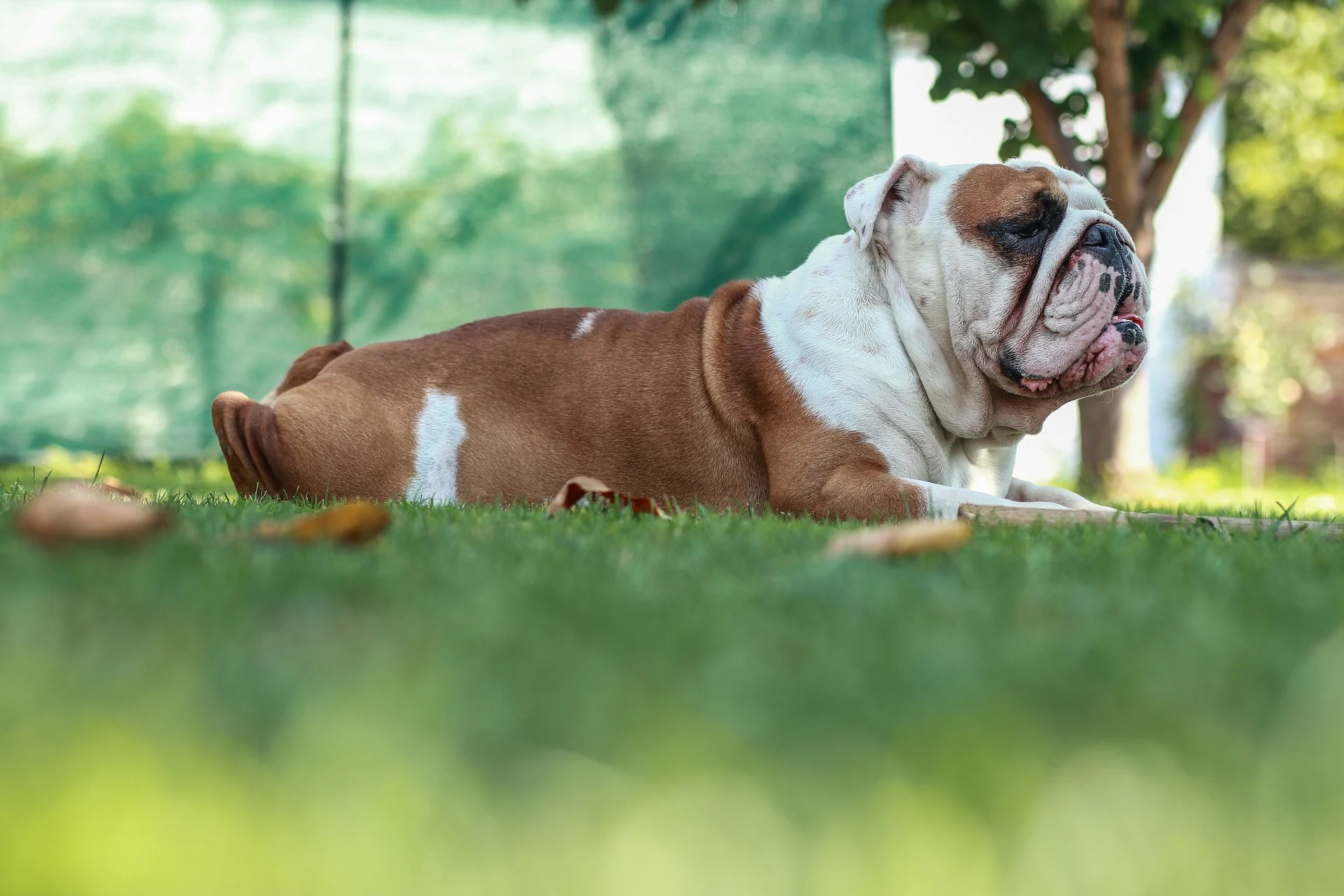If you are looking for a new family pet, then let us introduce you to the Olde English Bulldogge.
Don’t let their fancy name fool you, because these dogs are clowns at heart. They will make you laugh with their silly personality, and will quickly become your best friend.
They are a pretty low-maintenance breed, besides the endless amount of affection that they want from you.
The Olde English Bulldogge is a breed of bold, devoted, and well-behaved dogs. Children get along with them quite well, and they are naturally very protective of them.
This breed, which has a fairly calm demeanor, is actually a relatively recent recreation of the old dogs employed for bull-baiting.
Their ancestors were called Old English Bulldogs, but sadly, they have been extinct for years now.
If you are a fan of Bulldog breeds but are scared off by the numerous health problems that these dogs have, then we have great news for you. The Olde Bulldogge has a longer snout than his cousins, which means that breathing is a lot easier for him. Even in hotter weather, and even while exercising. We will talk more about their health later on in the article.
There are so many other things that make this breed unique and desirable. So if you want to learn all about Olde Bulldogs, then keep on reading this article. We have all the info that you could need before calling one of these babies your own.
| Fact Category | Olde English Bulldogge Quick Facts |
|---|---|
| Origin | United States |
| Size | Medium |
| Breed Group | Working Group |
| Life Expectancy | 9-14 years |
| Height | Males: 17-20 inches, Females: 16-19 inches |
| Weight | Males: 60-80 lbs, Females: 50-70 lbs |
| Coat Type | Short, smooth, and dense |
| Coat Colors | Brindle, fawn, red, black, and various tri-colors |
| Grooming Needs | Low |
| Exercise Needs | Moderate |
| Temperament | Affectionate, loyal, friendly, protective, and confident |
| Socialization | Important for well-adjusted behavior |
| Training | Moderate; responds well to positive reinforcement |
| Good with Children | Yes |
| Good with Other Pets | Yes, with early socialization |
| Health Issues | Hip dysplasia, bloat, cherry eye, elbow dysplasia, and allergies |
| Living Environment | Adaptable to apartment or house living; needs access to moderate daily exercise |
| Popularity | Increasing |
Olde English Bulldogge Appearance and Physical Characteristics
The Olde English Bulldogge is a medium-sized, powerful dog with strong muscles and swift movement.
The Olde English Bulldogge is a medium-sized dog with a powerful and athletic build. Their body features prominent shoulders and strong shoulder blades, giving them an imposing presence. The OEB head is broad with a medium-length snout, improving their breathing compared to other bulldog breeds. Their nose color varies, with the tip of the nose often being darker than the rest. The eyes are wide-set, with eye rims that can match or contrast the coat color.
One unique feature of the Olde English Bulldogge is the variety of coat colors available, including the rare old lilac tri bulldog. Eye color can also range from light blue to dark brown, adding to the breed’s visual appeal.
The Olde English Bulldogge can easily be confused with its cousin, the American Bulldog at first appearance. He exudes the same sense of strength and power as a standard Bulldog because of his wide, bulldozer chest, strong legs, and powerful appearance. Mounted atop such broad shoulders is a neck that is either very short or pretty much nonexistent. He has a wide-set stance because his legs are placed in the corners of his body.
But there is one obvious difference. If you look past the lines on his face, you’ll notice he has a snout—not it’s a long one, but it’s there nonetheless. This significantly improves his ability to breathe and gives him more energy. His slightly longer snout is a huge advantage, especially compared to other brachycephalic breeds. However, don’t expect him to go on a run with you in the middle of summer.
The Olde English Bulldogge is surprisingly agile and athletic considering its large bones and naturally chubby dimensions. Although he is not designed for extreme speed, he is more than capable of participating in an intensive game of fetch without experiencing the same respiratory problems as a typical Bulldog. The short coat of the Olde English Bulldogge rests flat on his torso. The breed standard includes many different colors, such as solid fawn, black, red, or black and white.

Source: Instagram (@abby_theoeb)
History of the Olde English Bulldogge
David Leavitt created the Olde English Bulldogge, a rare breed, by breeding English Bulldogs with Pitbulls, Bullmastiffs, and American Bulldogs. Due to their breeding and breathing issues, he lost interest in English Bulldogs in 1971. He found that they didn’t resemble their more moderate and healthful forebears. David wanted to breed a dog that had the appearance of an 18th-century Bulldog, the attitude of a modern English Bulldog and was healthy, free of breathing issues and all the other ailments that modern English Bulldogs are prone to.
They have three times fewer health concerns than the modern Bulldog, however, they will never be able to sprint for miles on the hottest summer days as hounds can. One additional improvement is that cesarean sections are not required. However, breeding is still often done with artificial insemination. David’s goal was to create a Bulldog with the health and disposition to be able to serve people as more of a working dog than a pet. While OEBKC is breeding the dogs to be more family-oriented, David Leavitt is breeding them to be more of a working lines sort of dog. In order to distinguish their dogs from some of the other Olde English Bulldogge (OEB) lines that did not match their requirements, some OEB lines renamed their dogs to the Leavitt Bulldog in 2005.
Old English Bulldog vs Olde English Bulldogge
The Old English Bulldog or the English Bulldog is frequently what comes to mind when most people think of a bulldog. Surprisingly, the “real” Old English Bulldog is actually extinct. The modern-day English Bulldog, with its low stature, boxy form, and heavy wrinkles, is what we’ve come to instantly recognize as the classic bulldog.
The Olde English Bulldogge (OEB), which debuted in the 1970s in the United States, is sometimes confused with both of these breeds. The original, extinct Old English Bulldog—the athletic, nimble, bull-baiting breed of the 17th century—was the inspiration for this new breed in many ways.
Therefore, the Olde English Bulldogge and Old English Bulldog are not the same breeds. There isn’t a way that they could be because one of them doesn’t even exist anymore. However, many people do use their names synonymously, and so will we in this article.
Personality
The Olde English Bulldogge, despite his rough-and-tumble exterior, is a giant softie at heart. Words like “sweet,” “gentle,” and “eager-to-please” are used to describe the breed, which are beautiful qualities for any dog to possess. Their wear their hearts on their sleeve, and any negative remark you say to them will make them feel hurt. These dogs are surprisingly sensitive and easily affected by their owner’s mood.
But all of these qualities make them great family dogs! And there isn’t anything that these canines love more than their family. They are much healthier than the English Bulldog and can play and run around with kids without any breathing problems. They also adore their families and want to be with them all the time.
These dogs adore chewing on pretty much anything. So make sure you buy enough durable toys before your shoes or furniture become a target. Stay away from giving him rawhide stuff like pig’s ears and bones. But besides the occasional chewing, these dogs are pretty laid back. While they can handle more activity than other Bulldog breeds, they still shouldn’t be exercised too much or go on difficult runs or hikes. While they have a longer snout than their cousins, many still consider them a brachycephalic breed.
As friendly as these pups are, you still have to socialize them on time in order for the dogs to develop a calm and friendly temperament. As we already said, they are very sensitive. And for them to feel more comfortable in big and busy social situations, they have to be around different people and animals from an early age.
Olde English Bulldogge vs. Other Breeds
The Olde English Bulldogge can be compared to other breeds, such as the English Bulldog, Pitbull, and Leavitt Bulldog. When it comes to temperament and appearance, the Olde English Bulldogge is a well-rounded choice, offering the best of both worlds. It is less aggressive than a Pitbull and healthier than an English Bulldog. The Leavitt Bulldog, a close relative of the Olde English Bulldogge, shares many of the same qualities but may have slight differences in appearance and temperament.
Olde English Bulldogge Puppies
Bulldogge puppies are known for their playful and affectionate nature. When searching for a puppy, it is essential to find reputable Bulldogge breeders who prioritize health and temperament in their breeding stock. The United Kennel Club is an excellent resource for finding registered breeders and obtaining more information about the breed.
Living with an Olde English Bulldogge
Although Olde English Bulldogges may appear intimidating at first, they are actually kind and friendly dogs with eager personalities. They are incredibly obedient to orders and devoted to their families. Olde English Bulldogges are incredibly accommodating. They will soon become your best friend, and their friendly temperament and strong personality will quickly grow on you.
Olde English Bulldogges are strong and athletic dogs with outstanding stamina. They might, however, prefer leisurely strolls to long-distance runs. Olde English Bulldogges are gregarious and extroverted, even with strangers, and are always up for backyard playtime or chew-toy activities on the carpet. But if they detect a genuine threat, these dogs will cause a scene. Which makes them a good watch dog.
This breed has fewer health issues than other Bulldog types, and it’s easier for them to breathe even in the summer months. They still prefer cooler weather and aren’t really about excessive workouts and exercise. They don’t bark for no reason, and they most likely won’t interrupt any of your office calls.
Caring for an Olde English Bulldogge
Training Olde English Bulldogges isn’t particularly tough because they are an intelligent breed and instinctively want to please their owners. Use lots of positive reinforcement and make the training sessions short and fun. These dogs are easy to potty train, but if your pup is struggling, consider using a crate. Make sure you leash train them on time because they are strong and will pull if you don’t teach them otherwise. And lastly, as we already explained, make sure you socialize your dog on time.
When it comes to exercise, this breed requires a daily walk in nature or the dog park. They can be lively dogs when properly trained, but they are content with mild exercise as well. With simply light exercise, they can maintain their pretty decent physical condition and muscle tone. These dogs should not be trained to jump or engage in vigorous exercise when they are young puppies since they are inherently sluggish.
As for grooming, they are pretty low-maintenance. Their short and silky coat does not shed too much, and you only have to brush them a few times a week. These are clean dogs, and you only have to bathe them when you notice visible dirt or that stinky dog odor. Trim their nails whenever you hear them clicking on your floor, or ask your groomer to do it for you if you don’t know how.
Because they have wrinkles, make sure the skin between their wrinkles is always clean and dry. This will prevent skin infections. Clean their ears from time to time too, using a few cotton balls and a cleaning solution. And last but not least, brush their teeth every night. They are prone to dental disease, and brushing will remove plaque and bacteria.

Source: Instagram (@oeb_barney)
Old English Bulldog General Health Information & Life Expectancy
Just like with any other dog breed, you must be aware of specific health issues before bringing one of these puppies home. They are, however, one of the healthier Bulldog breeds, and if you keep them in good health with a healthy lifestyle, a balanced diet, and enough activity, they can have a life expectancy of up to 12 years.
The most common health issues in this breed are hip dysplasia, gastric dilatation volvulus (bloat), cherry eye, brachycephalic airway syndrome, heart disease, knee problems, dental disease, and difficult births and breeding (artificial insemination).
To avoid these conditions from happening, make sure you buy your dog from a reputable breeder. Make sure they have done all the tests necessary and that your dog is as healthy as possible.
Most common health problems
Hip dysplasia. Dogs with hip dysplasia have an abnormally formed hip socket. In this condition, the femur’s spherical ball does not fit properly into the pelvic socket. By developing cartilage over the damaged area, the body attempts to repair the damage, but this causes inflammation and other undesirable conditions, such as degenerative osteoarthritis. In severe cases, it may result in arthritis and lameness of the hind legs. This is a genetic condition, so make sure your breeder provides you with the necessary papers to prove your future pup is healthy.
Gastric dilatation volvulus. As harmless as ‘bloat’ may sound to you, this is actually a medical emergency. Big canines are more susceptible to this illness, which causes the stomach to twist and fill with gas. The surrounding tissue may perish or burst as a result of the condition’s pressure on the diaphragm and interruption of blood flow to the heart. Deep-chested and large breed dogs are more prone to bloat, and it’s more likely to happen after overeating or vigorous exercise.
Cherry eye. A disorder known as cherry eye affects the nictitating membrane, often known as the third eyelid. This condition is characterized by the protrusion or prolapse of soft tissue within the eye. It is frequently advised to undergo surgery or use topical anti-inflammatory medications. Sadly, there are no preventative measures.
Interesting Facts
- The Olde English Bulldogge is a recreation of the 18th-century bull-baiting dogs known for their strength and courage.
- David Leavitt developed the breed in the 1970s using a breeding program that focused on health, temperament, and a more athletic appearance.
- The breed’s general appearance is a combination of strength and agility, making them suitable for various activities, including obedience training and agility courses.
Frequently Asked Questions
Is an Olde English Bulldog a pitbull?
No, the Olde English Bulldogge is a separate breed from the Pitbull.
What two breeds make an Olde English Bulldog?
The Olde English Bulldogge is a mix of the English Bulldog, American Bulldog, Bullmastiff, and American Pit Bull Terrier.
Are Olde English bulldogs high maintenance?
No, Olde English Bulldogs are considered low-maintenance dogs, requiring minimal grooming and moderate exercise.
What is the rarest color of Olde English Bulldogge?
The rarest color is the old lilac tri bulldog.
Can Olde English bulldogs be aggressive?
Olde English Bulldogs are not typically aggressive, but early socialization and training are crucial for a well-adjusted pet.
Are English Bulldogs as aggressive as pitbulls?
No, English Bulldogs are generally less aggressive than Pitbulls.
What is the most aggressive Bulldog breed?
The American Bulldog is often considered the most aggressive bulldog breed.
Do Olde English bulldogs like to cuddle?
Yes, Olde English Bulldogs are affectionate dogs that enjoy cuddling and spending time with their families.
Are Olde English bulldogs good pets?
Yes, Olde English Bulldogs make excellent family pets due to their kind, friendly, and obedient nature.
Conclusion
Now that you have learned so much about the Old English Bulldog, you are probably wondering if this would be the right dog for you. Bulldogges make great pets, and they would fit in with many different lifestyles. They are an easy-going pup that loves to spend chill time with their owners. They make a great companion, and they also don’t mind your other animal or human children.
But if this is your first time owning one of the American bulldog breeds, you have to inform yourself about their immediate needs. They do better in cold climates, due to their breathing problems, and you can’t expect to go on long runs with them. If you are looking for a workout buddy, then look into a more athletic Bulldog breed.
In addition to that, while these dogs are more healthy than other brachycephalic breeds, they still can get sick. And the vet fees could easily build up. If you aren’t ready for the possible financial costs of owning an Old English Bulldog, rather be honest to yourself right away than leave your pup in a shelter.
But if that doesn’t scare you off, and you want a pup that enjoys relaxing, play time, and movie nights, then this might be the best dog for you! If you are already the proud owner of one of these beauties, make sure you leave us a comment telling us all about him or her.


Gary
Sunday 7th of August 2022
We've had our Gemma for 5 yrs. She is the greatest dog I've ever had. I recommend the OEB to any and everybody.
James Kirkland
Monday 8th of August 2022
Thank you for sharing Gary <3